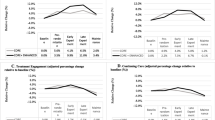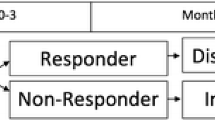Abstract
Implementation of effective substance abuse treatment programs in community settings is a high priority. The selection of a proven cost-effective model is a first step; however, difficulty arises when the model is imported into a community setting. The Center on Substance Abuse Treatment selected a brief substance abuse treatment program for adolescents, the MET/CBT-5 program, determined to be the most cost-effective protocol in the Cannabis Youth Treatment trial, for implementation in two cohorts of Effective Adolescent Treatment grantees. A qualitative investigation of the protocol implementation with nine sites in the second cohort chronicled adaptations made by grantees and prospects for sustainability. The study found that agencies introduced adaptations without seeming to be aware of potential effects on validity. In most sites, sessions were lengthened or added to accommodate individual client needs, address barriers to client participation, and provide consistency with current norms of treatment. Implications for fidelity of future implementation projects are addressed.
Similar content being viewed by others
References
Dennis ML, Godley SH, Diamond GS, Babor T, Donaldson J, Liddle H, et al. The Cannabis Youth Treatment (CYT) Study: Main findings from two randomized trials. Journal of Substance Abuse Treatment. 2004;27:197–213.
Institute of Medicine. Bridging the Gap between Practice and Research: Forging Partnerships with Community-Based Drug and Alcohol Treatment. Washington, D.C.: National Academy Press; 1998.
Perl HI, Dennis ML, Huebner RB. State-of-the-art methologies in alcohol-related health services research. Addiction. 2000;95(s3):275–280.
Fixsen DL, Naoom SF, Blase KA, Friedman RM, Wallace F. Implementation Research: A synthesis of the literature. 2005. Tampa, FL, The National Implementation Research Network, Louis de la Parte Florida Mental Health Institute, University of Florida.
Fixsen DL. Multilevel influences on successful implementation: A framework. 2006. Baltimore, MD. March 26, 2006.
Liddle H, Rowe CL, Quille TJ, Dakof GA, Scott Mills D, Sakran MS, et al. Transporting a research-based adolescent drug treatment into practice. Journal of Substance Abuse Treatment. 2002;22:231–243.
Simpson DD. A conceptual framework for transferring research to practice. Journal of Substance Abuse Treatment. 2002;22(4):171–182.
Liddle H, Rowe CL, Gonzalez A, Henderson CE, Dakof GA, Greenbaum PE. Changing provider practices, program environment, and improving outcomes by transporting Multidimensional Family Therapy to an adolescent drug treatment setting. The American Journal on Addictions. 2006;15:102–112.
Dennis ML, White MK. The effectiveness of adolescent substance abuse treatment: A brief summary of studies through 2001(prepared for Drug Strategies adolescent treatment handbook). Bloomington, IL: Chestnut Health Systems; 2003.
Lofland J, Lofland LH. Analyzing social settings: A guide to qualitative observation and analysis. 3rd ed. New York: Wadsworth Publishing; 1995.
Luborsky MR. The identification and analysis of themes and patterns. In: Gubrium J, Sankar A, eds. Qualitative methods in aging research. New York, NY: Sage Publications; 1994.
Miles MB, Huberman AM. Qualitative Data Analysis. 2nd ed. Thousand Oaks: Sage Publications; 1994.
Charmaz K. Grounded theory: Objectivist and constructivist methods. In: Denzin NK, Lincoln YS, eds. Handbook of Qualitative Research. Thousand Oaks, CA: Sage; 2000:509–535.
Guba EG, Lincoln YS. Paradigmatic controversies, contradictions, and emerging confluences. In: Denzin NK, Lincoln YS, eds. The Sage Handbook of Qualitative Research. Thousand Oaks, CA: Sage Publications; 2005:191–216.
Mays N, Pope C. Assessing quality in qualitative research. British Medical Journal. 2000;320(7226):50–52.
Pope C, Ziebland S, Mays N. Qualitative research in health care: Analysing qualitative data. British Medical Journal. 2000;320(7227):114–116.
Diamond GS, Godley SH, Liddle HA, Sampl S, Webb C, Tims FM, et al. Five outpatient treatment models for adolescent marijuana use: A description of the Cannabis youth Treatment interventions. Addiction. 2002;97(Suppl. 1):S70–S83.
Sampl S, Kadden R. Motivational Enhancement Therapy and Cognitive Behavioral Therapy for Adolescent Cannabis Users: 5 sessions. Rockville, MD: US DHHS; Substance Abuse and Mental health Services Administration, Center for Substance Abuse Treatment; 2001.
Hser Y, Grella CE, Hubbard RL, Hsieh S, Fletcher BW, Brown BS, et al. An evaluation of drug treatments for adolescents in 4 US cities. Archives of General Psychiatry. 2001;58:689–695.
Godley MD, Kahn JH, Dennis ML, Godley SH, Funk R. The stability and impact of environmental factors on substance use and problems after adolescent outpatient treatment for cannabis abuse and dependence. Psychology of Addictive Behaviors. 2005;19(1):62–70.
Butler AC, Chapman JE, Forman EM, Beck AT. The empirical status of cognitive–behavioral therapy: a review of meta-analyses. Clinical Psychology Review. 2006;26:17–31.
Robbins MS, Bachrach K, Szapocznik J. Bridging the research-practice gap in adolescent substance abuse treatment: the case of brief strategic family therapy. Journal of Substance Abuse Treatment. 2002;23(2):123–132.
Sofaer S. Qualitative methods: What are they and why use them? Health Services Research. 1999;34(5):1101–1118.
Patton GC, McMorris BJ, Toumbourou JW, Hemphill SA, Donath S, Catalano RF. Puberty and the onset of substance use and abuse. Pediatrics. 2004;114(3):300–306.
Hingson R, Heeren T, Winter M, Wechsler H. Magnitude of alcohol-related mortality and morbidity among U. S. college students ages 18–24: Changes from 1998 to 2001. Annual Review of Public Health. 2005;25:259–279.
Yi H, Williams GD, Smothers BA. Trends in alcohol-related fatal traffic crashes United States, 1977–2002. Surveillance Report No. 69. 2004. Bethesda, MD, National Institute on Alcohol Abuse and Alcoholism.
Johnston LD, O’Malley PM, Bachman JG. Monitoring the future national results on adolescent drug use: Overview of key findings. 67. 2005. Bethesda, MD, National Institute on Drug Abuse. NIH Publication No. 06-5882.
Office of Applied Studies (OAS). Treatment Episode Data Set (TEDS) 1993–1998: National admissions to substance abuse treatment services. 2000. Rockville, MD, SAMHDA.
Dennis ML, Dawud-Noursi S, Muck R, McDermeit M. The need for developing and evaluating adolescent treatment models. Binghamton, NY: Haworth Press; 2003.
Schoenwald SK, Hoagwood K. Effectiveness, transportability, and dissemination of interventions; What matters when? Psychiatric Services. 2001;52(9):1190–1197.
Kazdin AE, Weisz JR. Identifying and developing empirically supported child and adolescent treatments. Journal of Consulting and Clinical Psychology. 1998;66(10):19–36.
Dusenbury L, Brannigan R, Falco M, Hansen WB. A review of research on fidelity of implementation: Implications for drug abuse prevention in school settings. Health Education Research. 2003;18(2):237–256.
Acknowledgements
This research has been supported by a subcontract to the first author from Z-Tech Corporation through contract #N01AA21004 from the National Institute of Alcohol Addiction. We also acknowledge support for this project from the Center for Substance Abuse Treatment and its staff, Randy Muck and Jutta Butler, and their subcontracting Mayatech staff, including Darrel Fulmore. We are indebted to Cherry Lowman, Michael Dennis, and Susan Godley for reviews, comments, and insights. In addition, grateful thanks to Deena Goldsmith, MSW, and Helena Lightwolf, M.P.H. who provided staff assistance for this project.
Author information
Authors and Affiliations
Corresponding author
Rights and permissions
About this article
Cite this article
Riley, K.J., Rieckmann, T. & McCarty, D. Implementation of MET/CBT 5 for Adolescents. J Behav Health Serv Res 35, 304–314 (2008). https://doi.org/10.1007/s11414-008-9111-9
Received:
Accepted:
Published:
Issue Date:
DOI: https://doi.org/10.1007/s11414-008-9111-9




